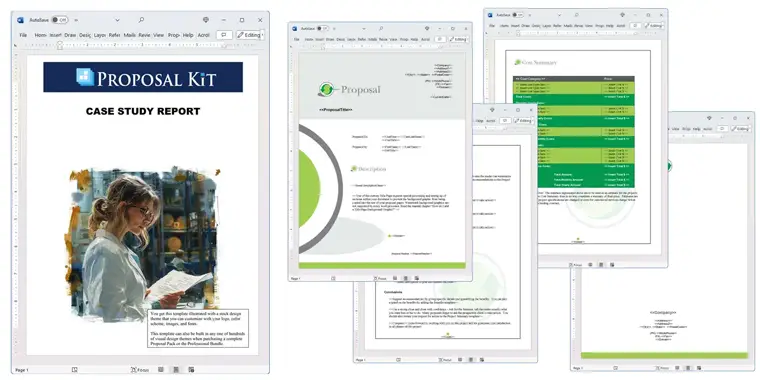How to write your Case Study Report
We include this 12 page layout with every Proposal Pack. If you want this template to have a different visual design theme than the one illustrated here, purchase any Proposal Pack design and create this template using the purchased design theme. This template is included in every Proposal Pack. If you get a Proposal Pack or the Professional, you can also make any variation of this template with different chapters to suit your needs.
We typically include more chapters in the templates than most people will need to give everyone more variety in the chapters they may need. You can trim down a long template by removing pages you do not need or combining multiple chapter topics into one page.
 DOWNLOADABLE, ONE-TIME COST, NO SUBSCRIPTION FEES
DOWNLOADABLE, ONE-TIME COST, NO SUBSCRIPTION FEESThis sample proposal is based on the same layout as this template and is included in every Proposal Pack. The visual design of the templates will match whichever Proposal Pack design you purchase. To get this template in a different design theme than shown in the sample, purchase any other Proposal Pack design theme and this template will be included.
You can create an editable Word version of this sample in any design theme of your choice including branded to your logo.
You can also create countless variations of this document to suit your needs using the included library of 2200+ chapters if ordering a Proposal Pack or Professional.
 What Our Clients Say
What Our Clients SayJust used one of your packs today and finished a business proposal in one day that would otherwise have taken me a week to do and the result was far more professional looking."
Related Article
Related Video
Related Templates
- Healthcare Case Study
- Feasibility Study and Analysis
- Feasibility Study for Business Startup
- Franchise Purchasing Proposal
- Feasibility Study Report
- Case Study Proposal Template
- Community Action Report to Fight Police Abuse
- Internship Report
- Standard Operating Procedure Document
- Business Case Document
- BANT Sales Proposal Template
- Population Migration Due to Climate Change Study
- Bankruptcy and Foreclosure Crisis Report
- Extinction and Climate Change Study
- Reserve Study
Writing a Case Study Report Using Proposal Kit
Many professionals find themselves in a predicament when tasked with writing a case study. The challenge is not only in compiling the data but also in presenting it in a coherent, compelling manner that highlights the study's findings and implications. For those unfamiliar with the nuances of creating such documents, the process can seem overwhelming. However, Proposal Kit offers a streamlined solution to this common problem.
What is the Best Way to Write a Case Study Report?
A proven approach to writing a case study report, especially for those with little to no experience, involves leveraging the Proposal Kit software and template library. This comprehensive tool simplifies the process, guiding users through each step of document creation. From outlining the abstract to compiling data and drawing conclusions, Proposal Kit provides a structured framework that ensures no critical element is overlooked.
One of the standout features of Proposal Kit is its integration of a line item quoting database system. This functionality is invaluable for including financial topics like cost summaries, quotes, estimates, budgets, and more within your case study. It allows for a detailed and accurate presentation of the financial aspects related to your study, enhancing the report's credibility and usefulness.
The Expert Edition of the Wizard software lets you build custom line item databases so you can define your own fields and calculations that are automatically built into tables in the documents you create for your case study.
What Types of Projects Are Case Studies Written For?
Case studies can cover a broad spectrum of projects, each with unique insights and lessons. Examples include:
- Market research for new product launches
- Impact analysis of marketing strategies
- Evaluation of new business models
- Feasibility studies for expansion plans
- Performance reviews of technology implementations
- Analysis of customer service improvements
- Studies on workforce productivity measures
- Investigations into supply chain efficiencies
- Reviews of corporate sustainability practices
- Assessments of educational program outcomes
Chapters this template is built with
It's important to note that Proposal Kit is not limited to proposals; it is equally adept at creating various business documents, including reports and plans. This flexibility makes it an indispensable tool for professionals across industries. One tool for all your custom documents.
By meticulously addressing each of these components, a case study report created using Proposal Kit can achieve a high level of professionalism and depth, making a significant impact on its intended audience.
These templates, along with the ability to save documents in PDF format for easy sharing, make Proposal Kit an effective solution for creating professional-grade case study reports.
Proposal Kit caters to a diverse range of needs through its extensive template library of thousands of chapter topics you can include in your case study, which includes, but is not limited to, the following chapters:
Abstract
The abstract is the gateway to your case study, offering readers a concise summary of what the study entails and its conclusions. It should encapsulate the purpose of the case study, the methods used for data collection and analysis, and the key findings or recommendations. The abstract serves to pique the interest of the reader, providing enough information to understand the study's significance without delving into the details. It's a balancing act of being brief yet comprehensive, ensuring that the essence of the case study is communicated effectively.
Present Situation
This section sets the stage for your case study by outlining the current scenario or issue that prompted the study. It involves a detailed description of the problem, including who is affected, the scope of the issue, and any previous attempts to address it. The present situation provides the context necessary for understanding the importance of the case study and sets the baseline from which changes or impacts can be measured. It's crucial for establishing the relevance of the study to the reader.
Project Background
Delving into the history or background of the project provides a deeper understanding of the context surrounding the case study. This section covers the origins of the project, including any events, trends, or decisions that led to the current situation. It may also include a review of previous studies or projects related to the topic. Providing this background helps readers grasp the complexity of the issue and appreciate the nuances involved in addressing it.
Literature Review
The literature review synthesizes existing research and data relevant to the case study's focus. This section demonstrates the researcher's thorough understanding of the topic by highlighting what has been studied previously, identifying gaps in the knowledge, and showing how the current study contributes to the field. It sets the foundation for the case study by situating it within the broader academic or professional discourse, ensuring the research is grounded in existing knowledge.
Evaluation and Analysis
This core section of the case study report involves a detailed examination of the data collected during the study. It goes beyond merely presenting data, engaging in a critical assessment of what the data reveals about the problem or situation at hand. This analysis should draw on the theoretical frameworks or methodologies outlined earlier in the report, applying them to interpret the significance of the findings. It's where the researcher's insights and analytical skills are showcased, providing a robust argument supported by evidence.
Data and Statistics
Presenting the quantitative evidence is fundamental to substantiating the case study's findings. This section details the data collected, including how it was gathered, analyzed, and what it signifies. Charts, graphs, and tables are often used to illustrate the data visually, making it easier for readers to grasp complex information. Clear and precise presentation of data and statistics is crucial for building a compelling evidence-based argument.
Lessons Learned
Reflecting on the key takeaways and implications of the study, this section distills the essence of what has been learned. It should address both the successes and challenges encountered, offering insights that can inform future projects or research. Lessons learned are valuable for both practitioners in the field and the academic community, contributing to a deeper understanding of the subject matter and how best to approach similar issues in the future.
Interviews
Incorporating insights from discussions with stakeholders or experts adds depth and perspective to the case study. This qualitative data enriches the quantitative analysis, providing context and personal experiences that highlight the human element of the study. Interviews can reveal nuances and complexities not evident in numerical data, offering a more rounded view of the situation.
Summary
The conclusion of the case study report brings everything together, summarizing the findings and offering recommendations based on the analysis. This section should reiterate the importance of the study, the key findings, and propose next steps or solutions to the problem. The summary is your final opportunity to convince the reader of the validity and significance of your research, leaving a lasting impression of the study's contribution to the field.
Use cases for this template
Healthcare Research Breakthrough
Harper's journey began with a challenging assignment: to conduct a comprehensive case study on an innovative treatment that promised to revolutionize a specific area of healthcare. The treatment, still in its nascent stages, had shown promising results in preliminary studies, but a detailed analysis of its development, implementation, and outcomes was needed to convince the broader medical community of its efficacy and safety.
Faced with this task, Harper turned to Proposal Kit, a decision that transformed the daunting process into a structured and manageable project. The software's vast library of templates provided a robust framework for the report, ensuring that no critical aspect was overlooked. The Abstract and Present Situation templates helped Harper set the stage for the study, outlining the current healthcare challenges the treatment aimed to address and its potential impact.
The Project Background and Literature Review sections allowed Harper to delve into the historical context of the treatment's development and summarize existing research, establishing a solid foundation for the study. The Evaluation and Analysis templates were particularly valuable, guiding Harper through a critical assessment of the collected data, which included both statistical outcomes of the treatment and qualitative feedback from patients and healthcare professionals.
Proposal Kit's integrated database system for line item quoting proved indispensable for presenting cost summaries, budgets, and financial projections related to the treatment's implementation. This feature not only streamlined the financial analysis but also added a layer of professionalism to the report.
The culmination of Harper's efforts was a comprehensive case study that illuminated the treatment's potential. The clear, concise, and well-structured report, enhanced by the capabilities of Proposal Kit, was published in a prestigious medical journal, contributing valuable knowledge to the healthcare community and marking a significant milestone in Harper's research career.
Product Viability Analysis
At InnovateTech, Jordan faced the task of evaluating a product idea within a limited timeframe. The challenge was not just to assess the product's feasibility but to present the findings in a manner that would resonate with the company's decision-makers.
Proposal Kit became Jordan's tool of choice in this endeavor. The software's templates for Abstract, Present Situation, and Project Background provided a clear outline for introducing the product idea, setting the context, and tracing its inception. The Literature Review section helped Jordan benchmark the product against existing solutions, identifying gaps in the market it could fill.
The heart of Jordan's analysis lay in the Evaluation and Analysis sections, where Proposal Kit's structured approach facilitated a deep dive into the product's potential impact, market viability, and technical feasibility. The Data and Statistics templates allowed Jordan to present the market research and financial forecasts in a compelling format, making the case for the product's success.
Jordan's report, enriched by the comprehensive features of Proposal Kit, not only met the boss's expectations but provided a strategic perspective on the product's place in the market. The decision-making process was significantly influenced by the report, showcasing the software's effectiveness in supporting high-stakes business analyses under tight deadlines.
Non-Profit Initiative Evaluation
For non-profit organizations, where resources are scarce and the need is great, Taylor's task was to demonstrate the tangible impact of GlobalBetterment's initiatives on improving living standards. Proposal Kit offered Taylor a pathway to create a report that could communicate the non-profit's achievements and areas for growth in a compelling and professional manner.
Using Proposal Kit's templates, Taylor structured the report to highlight the Present Situation of the communities the non-profit aimed to assist, providing a stark picture of the challenges they faced. The Project Background and Literature Review sections contextualized the non-profit's efforts within the broader scope of global development work.
Taylor's use of the Evaluation and Analysis templates was key in dissecting the data collected from the field, offering a nuanced view of the initiatives' outcomes. Interviews with community members, documented using the Interviews template, added powerful personal narratives to the quantitative data, enriching the report's impact.
The Lessons Learned section reflected on the successes and hurdles encountered, offering valuable insights for future projects. Taylor's meticulous compilation of data, stories, and analysis, facilitated by Proposal Kit, culminated in a report that not only showcased the non-profit's work but also played a pivotal role in securing further funding.
These situations - Harper's research breakthrough, Jordan's product analysis, and Taylor's evaluation of a non-profit initiative - illustrate the versatility and effectiveness of Proposal Kit in facilitating a wide range of complex projects. From healthcare research and business analysis to non-profit program evaluations, Proposal Kit proves to be an indispensable tool for professionals aiming to create detailed, impactful, and professionally structured documents.
Conclusions and Recommendations
Whether you're a seasoned professional or a novice tasked with creating a complex business document, Proposal Kit offers a comprehensive solution to the challenges of writing a case study report. Through detailed templates, a user-friendly interface, and an integrated financial database system, Proposal Kit ensures that your reports are not only thorough but also compelling and professionally presented.
If you find yourself in need of creating a case study report, consider leveraging Proposal Kit to navigate the process smoothly and effectively. Remember, your success in conveying the findings and implications of your study can have significant impacts on your project or business. Are you ready to turn your case study challenge into a success story with Proposal Kit?
Also Known As
This template may also be referred to in different ways or be used in more specialized situations, such as:
- Case Analysis Report
- Project Case Report
- Case Review Document
- Case Study Documentation
- Case Examination Report
- Project Analysis Report
- Case Study Evaluation
- Case Research Report
- Case Report Summary
- Case Investigation Report
Abstract
 An effective case study report requires an approach that captures the reader's attention and provides prospective customers with a clear understanding of the subject matter. Proposal Kit offers a structured solution to this challenge, guiding users through the important components of a case study, from the thesis statement to the final recommendations. By employing specific strategies and relevant facts, users can develop comprehensive reports that include important details such as diagnosis, prognosis, and potential solutions for identified issues.
An effective case study report requires an approach that captures the reader's attention and provides prospective customers with a clear understanding of the subject matter. Proposal Kit offers a structured solution to this challenge, guiding users through the important components of a case study, from the thesis statement to the final recommendations. By employing specific strategies and relevant facts, users can develop comprehensive reports that include important details such as diagnosis, prognosis, and potential solutions for identified issues.
The Proposal Kit software simplifies the process of writing a case study report through its comprehensive template library and integrated line item quoting database system. This allows for the detailed presentation of financial topics such as budgets, estimates, and cost summaries, which are crucial for evaluating the practicality and value of the study. The software's flexibility in research design enables users to examine real-life examples and case reports across various sectors, including medicine, business, and non-profit initiatives.
Incorporating background information and clinical observations, users can develop a well-rounded narrative that describes the case's context and relevance. The case study templates assist in outlining key points, structuring the article, and synthesizing data and statistics, ensuring a thorough exploration of the case. Through interviews with other stakeholders or potential customers, qualitative insights complement the quantitative data, enriching the overall analysis.
 Proposal Kit's templates also facilitate the evaluation and analysis of data by guiding users through critical assessments of collected information. This structured approach helps identify lessons learned and articulate possible solutions, enhancing the report's credibility and impact. By using Proposal Kit, professionals can communicate their findings, ensuring that their case study reports contribute valuable knowledge to their respective fields and resonate with their intended audience.
Proposal Kit's templates also facilitate the evaluation and analysis of data by guiding users through critical assessments of collected information. This structured approach helps identify lessons learned and articulate possible solutions, enhancing the report's credibility and impact. By using Proposal Kit, professionals can communicate their findings, ensuring that their case study reports contribute valuable knowledge to their respective fields and resonate with their intended audience.
The Proposal Kit provides the tools necessary to prepare and present a case study report. From the initial identification of research objectives to the final discussion of implications, the software equips users to navigate the complexities of case study analysis. Whether focusing on healthcare breakthroughs, product viability, or non-profit evaluations, Proposal Kit proves to be an indispensable resource for professionals aiming to generate detailed, impactful, and professionally structured documents.
Proposal Kit's utility extends beyond merely assembling documents; it offers a systematic approach to tackling complex projects across various disciplines. For instance, when tasked with a case study in healthcare, a practitioner might begin by defining the disease or condition in question, using the Proposal Kit's guidelines to frame the introduction. This involves setting an objective to explore the treatment's effectiveness, establish the criteria for success, and formulate a hypothesis that aligns with existing research.
 The software supports the creation of a checklist to ensure all necessary components are addressed, such as the collection of symptoms and the subsequent diagnosis. Proposal Kit's structure aids in the consistent documentation of clinical findings, allowing the researcher to investigate specific topics of patient care and develop insights into potential consequences and solutions.
The software supports the creation of a checklist to ensure all necessary components are addressed, such as the collection of symptoms and the subsequent diagnosis. Proposal Kit's structure aids in the consistent documentation of clinical findings, allowing the researcher to investigate specific topics of patient care and develop insights into potential consequences and solutions.
In the business realm, Proposal Kit's templates help in evaluating market opportunities or assessing new business models. By using case study examples, businesses can relate their findings to past projects, identify limitations, and explore practical strategies for improvement. The net effect of using Proposal Kit is a well-prepared report that highlights important details, such as financial projections and recommendations, presented in a manner that is accessible to both experts and laypersons.
For non-profit organizations, Proposal Kit facilitates the preparation of reports that illuminate the impact of their initiatives. By incorporating interviews and firsthand accounts, the report can convey the lived experiences of individuals affected by the organization's efforts, offering a narrative that resonates with potential donors and stakeholders. The software's ability to integrate data from various sources ensures a comprehensive evaluation that is both credible and actionable.
 Proposal Kit also caters to academic institutions and colleges, where case studies serve as a tool for both teaching and research. By providing a framework for the systematic analysis of real-life situations, Proposal Kit enhances the educational experience, allowing students and researchers to look into complex topics with confidence. The software's robust features enable the development of well-structured articles and papers that are suitable for publication or presentation.
Proposal Kit also caters to academic institutions and colleges, where case studies serve as a tool for both teaching and research. By providing a framework for the systematic analysis of real-life situations, Proposal Kit enhances the educational experience, allowing students and researchers to look into complex topics with confidence. The software's robust features enable the development of well-structured articles and papers that are suitable for publication or presentation.
Overall, the Proposal Kit is an indispensable resource for anyone involved in creating detailed and impactful case study reports. Its versatility and comprehensive features make it applicable across a wide range of fields, ensuring that users can communicate their findings and contribute valuable insights to their respective industries. By integrating the Proposal Kit into their practice, professionals can transform their case study challenges into successful outcomes, leading to informed decisions and meaningful progress.
Frequently Asked Questions
What should I include in a Case Study Report?
Start with an Executive Summary that briefly overviews the case study, including the main findings and conclusions. Include a Background section that describes the context and relevance of the case. The Methodology section should detail the methods used to gather data and analyze the case. Present the Findings clearly, outlining the key results and insights from the case study. Finally, the Conclusion and Recommendations section should summarize the main points and suggest any actions or implications based on the findings.
How do I choose the right case for my Case Study Report?
Select a case relevant to your field or topic of interest, with sufficient data available for analysis. It should offer significant insights or lessons that can be applied to similar situations. Consider the uniqueness or typicality of the case; unique cases can provide deep insights, while typical cases can illustrate common issues and solutions. Ensure that the case aligns with the objectives of your study and can contribute valuable information to your research question or goals.
What can I do to analyze data in my Case Study Report?
Use both qualitative and quantitative data to provide a well-rounded analysis. Apply relevant theories or frameworks to interpret the data and draw connections. Look for patterns, trends, and anomalies that can provide insights into the case. Use visual aids, such as charts and graphs, to present data clearly and support your analysis. Ensure that your analysis is systematic and unbiased, providing a thorough examination of the case.
How do I ensure my Case Study Report is credible and reliable?
Use multiple sources of data to corroborate your findings and provide a comprehensive view of the case. Clearly document your methodology, including how data was collected and analyzed, to allow for reproducibility and transparency. Use direct quotes and specific examples to support your analysis and provide evidence for your conclusions. Peer review and feedback from experts in the field can also enhance the credibility of your report. Maintain objectivity and avoid bias in your interpretation of the data.
What are mistakes to avoid when writing a Case Study Report?
Stay focused by clearly defining the scope and objectives of your study. Ensure that your report is not too descriptive; instead, focus on analysis and insights. Avoid insufficient data by thoroughly researching and gathering adequate information to support your findings. Be cautious of bias and subjectivity; strive for objectivity in your analysis and conclusions. Finally, avoid poor organization by structuring your report logically and clearly, making it easy for readers to follow and understand your findings.
20% Off Discount
![]() Add To Cart This Word Template
Add To Cart This Word Template
 Add To Cart Proposal Pack Environmental #3
Add To Cart Proposal Pack Environmental #3
 Add To Cart Proposal Kit Professional
Add To Cart Proposal Kit Professional
 4.7 stars, based on 849 reviews
4.7 stars, based on 849 reviewsProposal Kit chapters used in this template
Title Page, Table of Contents, Present Situation, Project Background, Literature Review, Interviews, Evaluation, Analysis, Data, Statistics, Lessons Learned, Back Page
You use this proposal for
- Construction, contracting, building proposal
- Business document, study, plan, report
- Nature, environmental proposal
How to create this template with Proposal Pack Wizard
You can create this document using any of the logo-designed Proposal Packs. Pick any Proposal Pack with a logo design theme you like best; they will all work equally well. The Proposal Pack for Any Business is the pack with no extra added logos or colors - designed to be used plain or for you to customize with your logos and graphics.
The Proposal Pack design theme you purchase will determine the visual look of this template. The screenshot above only shows the plain generic design theme.
We include a library of chapters to be assembled based on your needs. All proposals are different and have different needs and goals. We designed Proposal Pack so you can customize the documents to suit your needs.
You will best create this document using the Proposal Pack Wizard - Expert Edition software to select this template and build it in the Proposal Pack logo design theme of your choice along with any desired customizations (such as adding additional chapters, removing unneeded chapters, changing the order of chapters, and importing your company logo). This template outlines a proposal for the described situation. Each user is responsible for typing in the actual content of the provided pages with their information to complete the proposal. Suggestions in the abstract may include features in higher-end packages and are facilitated by the selection of chapter templates to support the narrative of each proposal, which help guide the user in filling in the details.
The Wizard software's AI Writer will write the content of the pages of the template based on details provided for your company, client, project, financial details and other writing instructions. This will provide a personalized version of the template completely written and ready to edit.
Once finished, the AI Writer's Word-to-PowerPoint converter can transform your proposal, business plan, or other business documents into a PowerPoint slideshow. Save time and effort by letting the AI analyze every chapter to condense its content into talking points, visually matching the document, and providing a consistent package of presentation material with the click of a button.
You create this template using the Wizard software with an entire Proposal Pack library and software. We include the Expert Edition of the software in the Proposal Kit Professional. Microsoft Word for Windows is required to use the customizing software. You can also edit Word document templates in other office software such as Word for Mac. We will assist Mac users in assembling complex templates for their first project if they do not have the required platform to run the Wizard software.
How to Build Templates Featured on Proposal Kit Website
Many people find the Proposal Kit website after searching for a specific proposal. Once you've purchased and installed the software, how do you build that template you found in the first place? This video shows you how to build any proposal you see on the Proposal Kit website.
 Ian Lauder has been helping businesses write their proposals and contracts for two decades. Ian is the owner and founder of Proposal Kit, one of the original sources of business proposal and contract software products started in 1997.
Ian Lauder has been helping businesses write their proposals and contracts for two decades. Ian is the owner and founder of Proposal Kit, one of the original sources of business proposal and contract software products started in 1997.By Ian Lauder
 Published by Proposal Kit, Inc.
Published by Proposal Kit, Inc.


 Cart
Cart
 Get 20% off ordering today:
Get 20% off ordering today: 


 Facebook
Facebook YouTube
YouTube Bluesky
Bluesky Search Site
Search Site